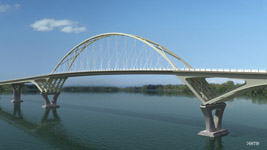The Lake Champlain bridge as a new model for New York state
 At yesterday’s meeting in Addison, Vermont, New York state officials and their contractors seemed baffled by their own efficiency.
At yesterday’s meeting in Addison, Vermont, New York state officials and their contractors seemed baffled by their own efficiency.
As recently as last October they assured local residents that reconstruction of the Lake Champlain bridge at Crown Point would take a minimum of five years.
Five months later, the DOT has already solicited a low bidder on the project, which at roughly $70 million came in under their cost estimates.
They’ve removed the old bridge and built a functioning ferry system, despite incredibly challenging conditions. Construction on the new span could begin as early as this month.
What’s more, state officials say they were able to secure every single environmental, historical and safety permit required for the project.
Perhaps most importantly, there have been no serious injuries or fatalities.
Now granted, this was an emergency. State workers can’t be expected to work round the clock, burning weekends and holidays, on every project.
But surely the effort at Crown Point teaches us something.
At a time when New York state has no choice but to trim state government, perhaps drastically, the Lake Champlain bridge shows that ambitious and important public work can get done quickly, efficiently and safely.
The next Governor should appoint a review team to study this success story and find out how to replicate it, not just for other DOT efforts but across state government.
That review should pose some thorny questions to top state officials:
Why did the DOT think it needed five years, if the work could really get done in 23 months? What assumptions were they operating under, and how can we eliminate as many of those mental and bureaucratic boxes as possible?
At a time when Albany is a national symbol for gridlock and government failure, the Crown Point effort can be a symbol of something better and more hopeful.
It was exciting to see that the project’s leaders shared that excitement and pride — not just at the development of a beautiful new bridge, but at their victory over red tape, waste and muddle.








Encouraging indeed. However, I wouldn’t get all misty eyed until it’s built and the first car drives across it. There’s still plenty of time for the bureaucracy to kick in and delay the completion.
Having said that, you pose a good question. Why does it take 5 years to build a bridge in the 21st century?
I’ll take a guess. There have probably been plans on the shelf to replace the aging bridge for some time. Those plans were probably careful to jump through every hoop, site consideration, etc…, and probably were to go in effect while the existing bridge still stood. Call it the “no hurry” plan.
A collapsing bridge tends to focus the mind and move up the timetable.
I think this part of the process has gone great and we should recognize the accomplishments, government can work well. But on the other hand I don’t think it can serve as a model until it is actually completed.
Don’t open the champagne yet, read this regarding the APA permit process:
“”There may be substantial vegetative cutting, grading and stormwater management necessary to provide sufficient area to allow construction of the tied arch,” APA staff said in the draft permit.
“Such a clearing-ground disturbance proposal will require a new or amended permit from (APA), and (DOT) has determined that applying for and receiving all required permits will be the responsibility of the contractor awarded the contract.”
APA was unable to provide “advance assurances that the permitting process for that activity, if required, would not result in potential delays for the bridge replacement project.””
But Brian you are correct things are going fast at this point. Now if we could just get the Governor and the state agencies to treat local economic development with the same urgency we might have some positive progress.
Paul,
Those don’t sound like insurmountable issues. Erosion control permitting is pretty straightforward. The APA can’t comment on a plan they haven’t received yet, so their response sounds like boilerplate to me. If the contractor knows what he’s doing, it shouldn’t hold up the construction.
My understanding is that the APA and the DEC have both already issued the needed permits for the project to go forward.
There are stipulations in the permit regarding shoreline protections, etc., but there are no further regulatory hurdles.
–Brian, NCPR
This is the first time I can remember that two communities stood up and demanded the same thing. To have the corridor re-opened as soon as possible with a temporary ferry and a new bridge at the same site as the old bridge. Yes, Government moved BUT it took a lot of pushing and demanding from the communities of New York State and Vermont to make it happend. They only moved fast because we pushed them to it. People can make a difference with Government if they stand strong together and don’t give up.